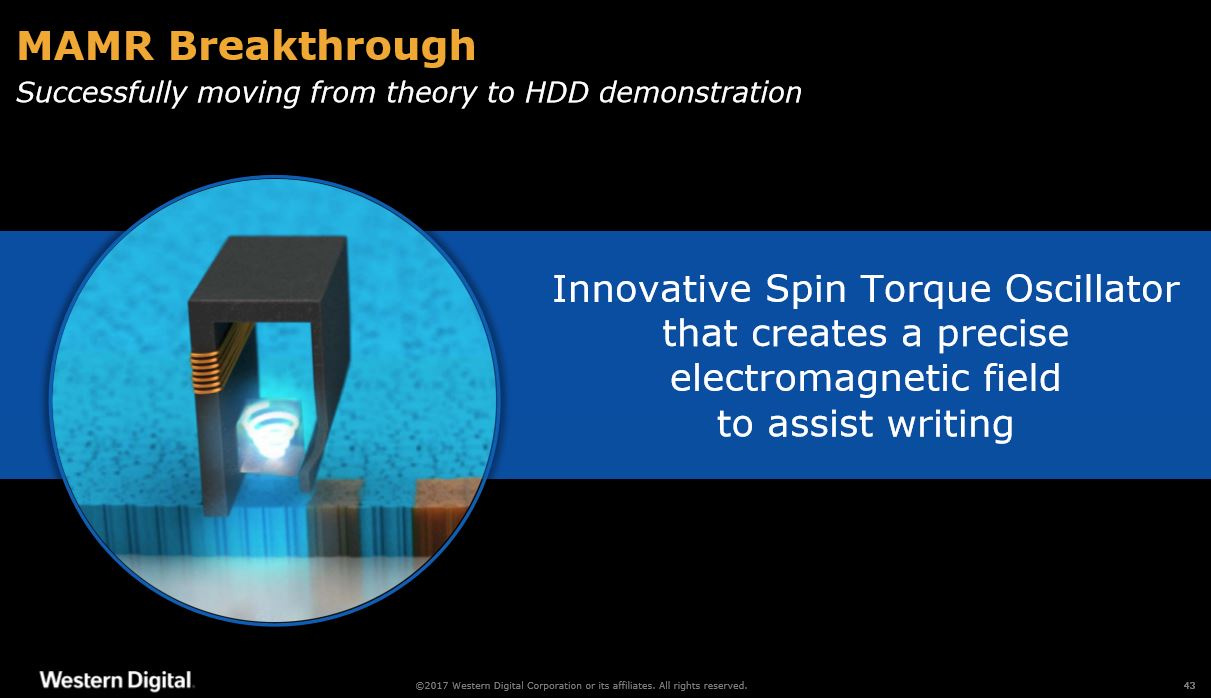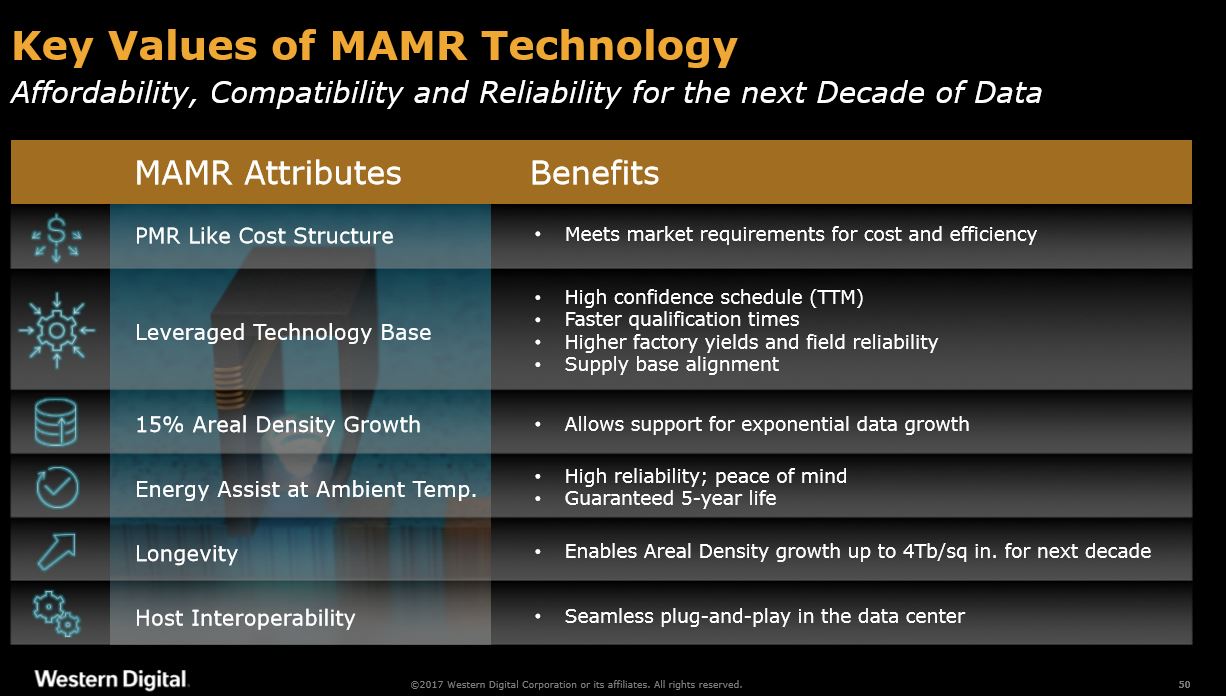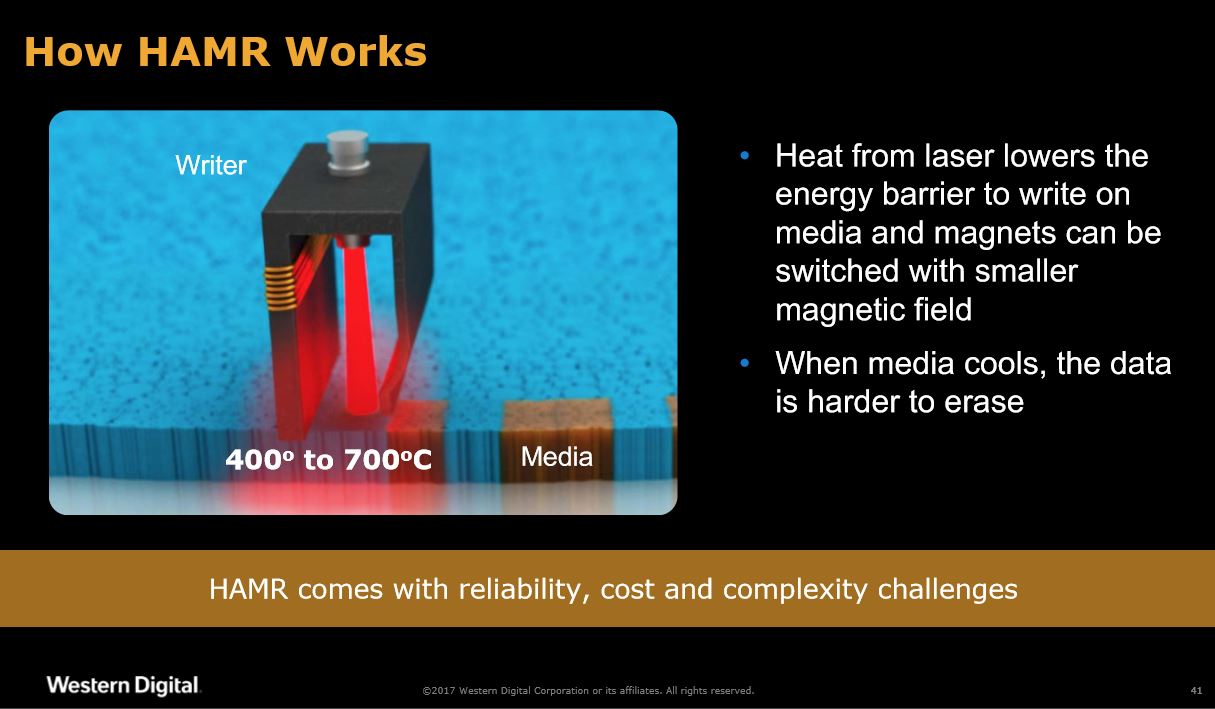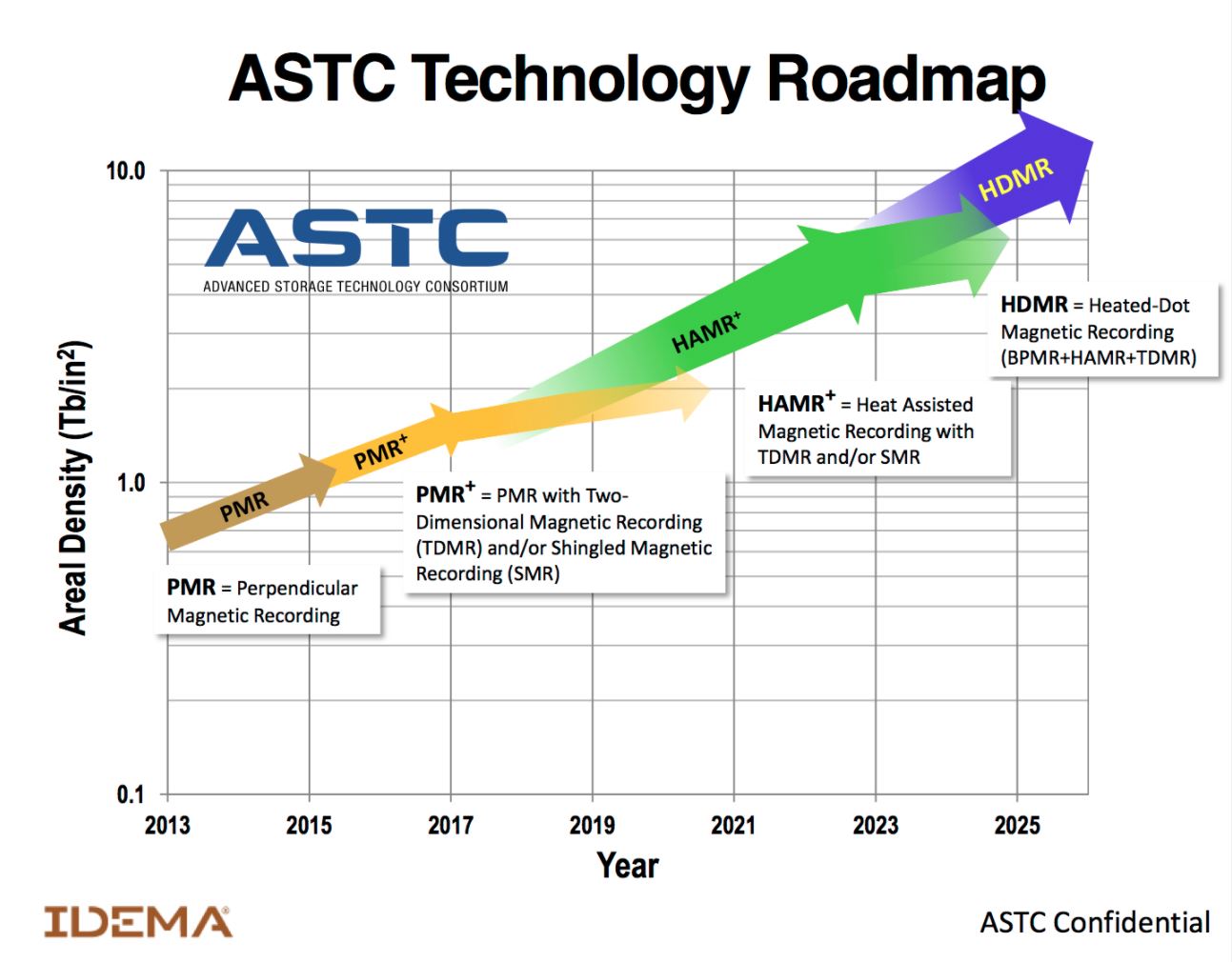Seagate Plans To HAMR WD's MAMR; 20TB HDDs With Lasers Inbound
Seagate is firing back at WD's MAMR with its HAMR (Heat Assisted Magnetic Recording) technology that uses tiny lasers to increase storage density. Seagate claimed the new HDDs will debut to the market in 2018, and the company has plans to bring 20TB+ drives to market in 2019. If that isn't enough storage for you, the company plans to have 40TB+ models by 2023.
HDD technology has become somewhat boring. Innovation has slowed, but that's largely because we've reached the limits of PMR (Perpendicular Magnetic Recording), which is the key underlying HDD recording technology. Over the last two years, we've seen a few interesting new technologies that let us cram more bits into the same old 3.5" HDD, such as SMR (Shingled Magnetic Recording). Unfortunately, the new tech comes with slower performance and often requires radical system changes if you want to unlock the full performance. That isn't worth the small capacity improvement unless you're deploying tens of thousands of HDDs.
So, much like the iterative advances we see with other types of technology, HDD capacity growth has traveled into the land of diminishing returns. The HDD vendors are aware of this, of course, and both WD and Seagate have been researching new recording techniques since the late '90s. Now it's time to make them real.
Fry All The Bits
WD surprised the storage world when it announced it would use its new MAMR (Microwave Assisted Magnetic Recording) technology, which uses a microwave field to boost recording density, instead of HAMR (Heat Assisted Magnetic Recording). WD's announcement included a litany of very convincing reasons why HAMR isn't the best path forward, but Seagate begs to differ. Seagate is sticking to its plans to use HAMR, and the company's latest disclosures dispute several of WD's claims.
HAMR boosts storage density by shooting a laser at the tiny recording bits, which reduces the amount of energy required to magnetize the media. This tiny laser, which is smaller than a grain of salt, rides on the HDD's recording head. But don't let the tiny size fool you; it heats the recording surface to over 400C. That's short-lived, though, because the media heats and cools within a nanosecond. The laser requires only ~200mW of power to accomplish this feat, so Seagate claimed its drives will fit within the standard HDD power envelope.
Seagate also claimed its HAMR technology is scalable; the company has increased the areal density by 30% annually over the last nine years, reaching up to 2 Tb/in2. That's twice the density of the current leading PMR HDDs. Seagate has already built over 40,000 HAMR drives and has them in the field with leading customers. According to Seagate, qualification is going as planned.
Adding lasers to the recording head brings about reliability concerns, which is one of the key reasons WD chose MAMR. Seagate claimed that its recording heads can write over 2PB of data without reliability concerns, which is well above the requirements for standard nearline HDDs. It's important to note the 2PB write endurance is with a single head, but high-capacity HDDs use multiple heads. Zooming out to the device level, that means Seagate's HAMR HDDs could theoretically write 35PB of data to a drive over a five-year period. That's well beyond the current 2.5PB endurance rating of most enterprise HDDs.
Get Tom's Hardware's best news and in-depth reviews, straight to your inbox.


WD also contends that HAMR increases head production cost, but Seagate countered that increased storage density yields a lower cost-per-TB. Seagate said it has already built "millions" of HAMR-infused heads, so the company is confident in its ability to cost-effectively produce them. Much like WD's plans for MAMR technology, Seagate plans to pair HAMR with other technologies, such as helium, SMR, and TDMR, to increase density as the technology matures.


HAMR requires new materials for platters, which is yet another reason WD isn't bringing the technology to market. Seagate will use platters with a glass substrate, which are already used in some HDDs on the market, and said it can achieve a 2.5 million hour MTBF. Contrary to WD's claims, Seagate says HAMR drives will not require wear leveling. That means they'll be plug-and-play with existing systems.
WD claims MAMR will top out at 4Tb/in2, whereas HAMR is widely projected to top out at ~10Tb/in2. In the future, Seagate plans to pair HAMR with Bit-Patterned Media, thus creating HDMR (Heated Dot Magnetic Recording). As if we didn't have enough acronyms already. In either case, Seagate claims HDMR could scale up to 100Tb/in2. WD might be able to take a similar path with MAMR.
The Long Game
Both vendors plan to begin volume shipments of their respective technologies in 2019. Seagate projects 40TB+ drives by 2023, and WD plans to pass the 40TB threshold in 2025. Seagate's more ambitious roadmap might be an advantage, but for now, it exists only on paper. We don't know of any concrete plans from HDD industry laggard Toshiba.
WD's MAMR relies largely upon proven technologies, which is a plus, but Seagate claimed that it's already producing the more exotic HAMR drives on the same production lines as its existing PMR-based drives. It also said that it has already built a strong supply chain for the new materials.
Both WD and Seagate have solid arguments for their chosen technologies, but the market will determine the winner. Both technologies will undoubtedly provide similar characteristics to today's HDDs, such as endurance, reliability, performance, and power specifications, so cost will be the true differentiator. As always, cheap and good enough will win.
The HDD industry settled on PMR recording in 2005, and all three big vendors continue to use the same underlying technology. The move to two different technologies should make for a more exciting HDD future.
Seagate plans to provide an update on its progress in early 2018.

Paul Alcorn is the Editor-in-Chief for Tom's Hardware US. He also writes news and reviews on CPUs, storage, and enterprise hardware.
-
wysir Finally, I'll be able to buy my own micro laser. The hard drive wont last under those temps.Reply -
simfreak101 They will still lose to flash in the long run. Samsung is already on gen5 of their flash at 128GB per die; Times 32 dies per package and you are already at 4TB per little black square on a pcb yielding a 128TB 2.5" drive at a fraction of the power usage and less physical real estate with 100x the performance (if not more :P) If Samsung continues these improvements they should reach near 2x cost premium compared with the new magnetic technologies coming out. Being that they already have a 9x capacity advantage over existing 14TB offerings, they have 6 years to ramp production to get the price parity down.Reply -
alextheblue Flash will remain too costly to completely supplant HDDs (outside perhaps of typical consumer usage) for the foreseeable future.Reply
Anyway, the Dr. Evil in me is really happy to see Seagates with frickin' laser beams on their heads.
Also, now when they explode they can pew pew lasers. -
zodiacfml HAMR, as mentioned already, can scale at higher capacities. Light simply has a smaller wavelength compared to microwaves. Flash has a better future though where these HDDs will replace magnetic tape drives.Reply -
samer.forums imagine how much time you will need scanning for bad sectors on that 20 Tera Harddisk ... or how much time you will need to write zeros on it to wipe it out lol ...Reply
having said that , The companies are competing in size and not competing in I/O sadly ... Where are the cheap consumer level 15K RPM drives ? I am waiting for them for decads and they never come.
If they can make 20 Terabytes 7200 RPM Drives , using the same density and smaller platters , they can make at least 6 Terabytes 15K RPM using the same density now .. what is stopping them ? 2.5 inch 15K Consumer level drives please ANYONE ?
the last one who did it was the WD Raptor ... we need Raptor 2 Western Digital , Just DO it . -
bit_user Reply
You're missing the point. The lasers/microwaves aren't use write the data, but rather to reduce the coercivity of the recording media. Consequently, the area heated by the laser or affected by the microwaves can be larger than a single track.20341611 said:HAMR, as mentioned already, can scale at higher capacities. Light simply has a smaller wavelength compared to microwaves.
"better future"? The challenge for flash would be merely to keep up with the density improvements of HDDs. We're already in a world where you use flash for speed and HDDs for cheap nearline capacity, and that won't change for the foreseeable future.20341611 said:Flash has a better future though where these HDDs will replace magnetic tape drives.
BTW, I doubt even these HDDs will offer the cheapest offline storage solution. Anyway, 100 GB blu-rays are a true archival medium, if not also the cheapest per GB. -
bit_user Reply
True.20341634 said:imagine how much time you will need scanning for bad sectors on that 20 Tera Harddisk
They could just store encrypted data, like some flash drives, and then you just have to wipe the key.20341634 said:... or how much time you will need to write zeros on it to wipe it out lol ...
Yes, because that's what flash is for.20341634 said:The companies are competing in size and not competing in I/O sadly
I doubt it's that simple.20341634 said:If they can make 20 Terabytes 7200 RPM Drives , using the same density and smaller platters , they can make at least 6 Terabytes 15K RPM using the same density now
You're nuts. OR a troll, but I'm going with nuts.20341634 said:.. what is stopping them ? 2.5 inch 15K Consumer level drives please ANYONE ?
I got a sweet deal on a 500 GB Raptor, back in the day. I replaced it with flash, years ago, and never looked back.20341634 said:the last one who did it was the WD Raptor
-
bit_user Reply
There are some SMR HDDs in the wild. I don't know if this is a trend, but I've heard rumors of them even showing up in the consumer market.20337734 said:The HDD industry settled on PMR recording in 2005, and all three big vendors continue to use the same underlying technology.
IMO, they're good for backup ...and not much else. -
WyomingKnott Now you will be able to get HDDs "with frickin' laser beams attached to their heads." Dr. Evil will be so happy.Reply


